Lisa Myeong-Joo, The Red Chair in Your Picture Does Not Exist, 2024, steel, plywood, PVC, vinyl, PU foam, acrylic, 400 x 84.5 x 42 cm. Photo: Jessica Maurer
The Red Chair in Your Picture Does Not Exist
Toyah Webb
The theatre term “properties” first appeared in 1425 in the script for a play called The Castle of Perseverance. Housed in the Folger Shakespeare Library in Washington DC, the manuscript depicts a sloping castle turret and what appears to be a low bench. Encircling the bench is a ditch, which the audience is instructed not to cross. This threshold, a line traced in the dirt, marks the limit between what is real and what is not, between what is “true” and what is only make-believe. The stage describes a world.
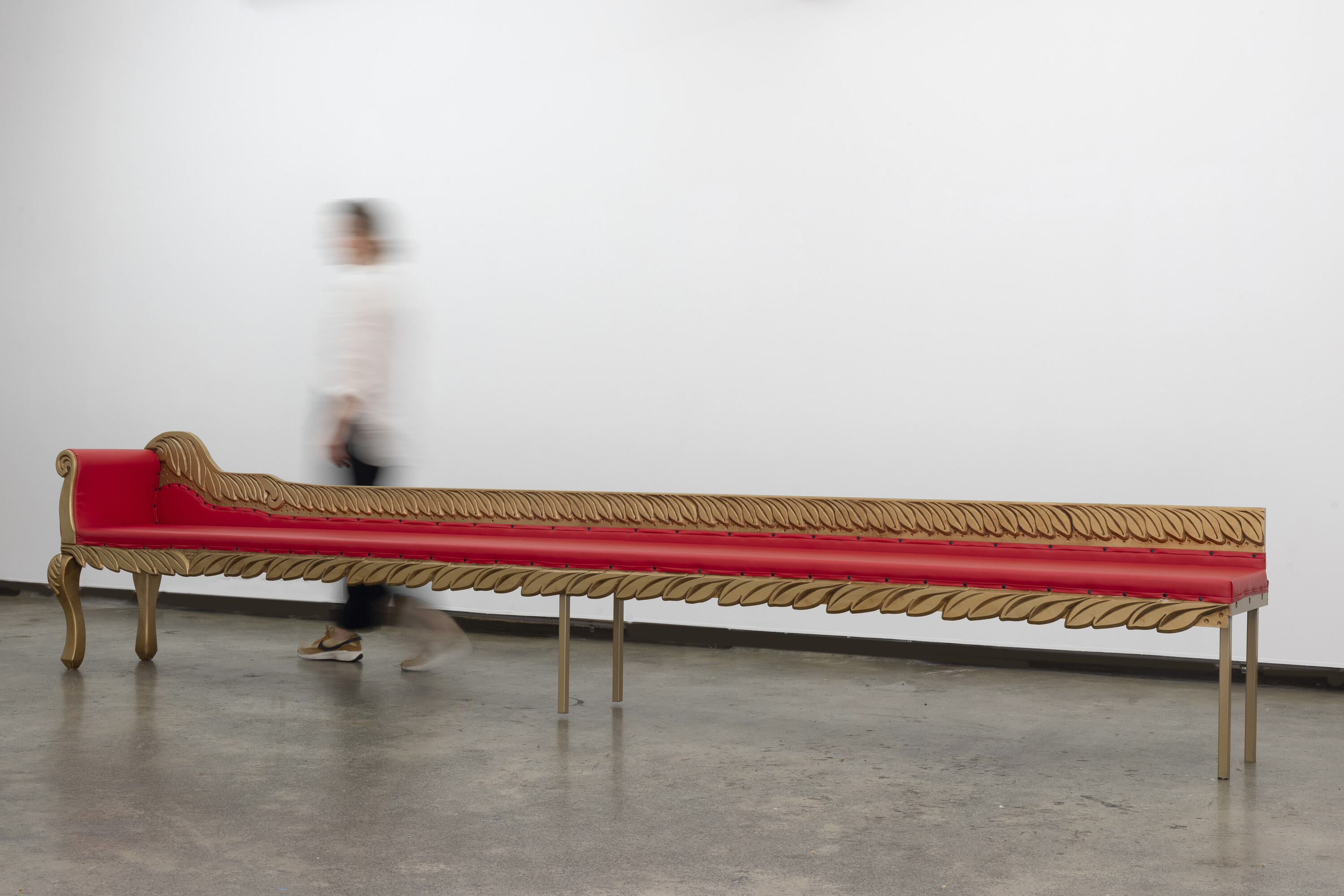
Lisa Myeong-Joo, The Red Chair in Your Picture Does Not Exist, 2024, steel, plywood, PVC, vinyl, PU foam, acrylic, 400 x 84.5 x 42 cm. Photo: Jessica Maurer
Lisa Myeong-Joo’s The Red Chair in Your Picture Does Not Exist (2024), currently showing at Firstdraft, is a re-staging, while it also refuses this term. The chair in question is a four-metre chaise lounge, upholstered in red vinyl and decorated with vaguely baroque banding. It is a reproduction of what the artist calls a “photo chair,” used by an adoption agency in Seoul to document children. The artist herself was photographed sitting on this chair thirty-six years ago. Between 1950–53, Korea became the stage for a US proxy war that orphaned approximately 100,000 children. Following the war, the adoption of Korean children was popularised by Harry and Bertha Holt, an evangelical couple from Oregon, who subsequently established Holt’s International Children’s Services, one of the largest adoption agencies operating in South Korea. Foreign adoption peaked in the mid-1980s when dictator Chun Doo-hwan deregulated the industry; since the 1950s, approximately 200,000 children from Korea have been adopted by families living abroad, with around 3,600 children adopted to Australia.
The “photo chair,” I learned from the room sheet, staged the first photo of a child for their adoptive family; two copies of the photo were sent to the new family, while a third copy was filed away in a drawer at the adoption agency. When Myeong-Joo contacted the agency to ask about the chair, she received a short bureaucratic email: “The red chair in your picture does not exist.” As the room sheet acknowledges, the email’s truth might have been lost in translation; but, still, it seems strange to refuse the integrity of a photo, one of three copies against which the truth may be verified. A photo (unless manipulated digitally) exists as documentary evidence, establishing a pact with the viewer that what the photographer depicts is the truth. As viewers, we only see a corner of the artist’s “first photo” on Firstdraft’s website, never in the gallery. Yet its referent is visible in the Myeong-Joo’s installation. Instead of accepting the agency’s impossible version of the past, The Red Chair in Your Picture Does Not Exist enacts a playful counter-refusal.
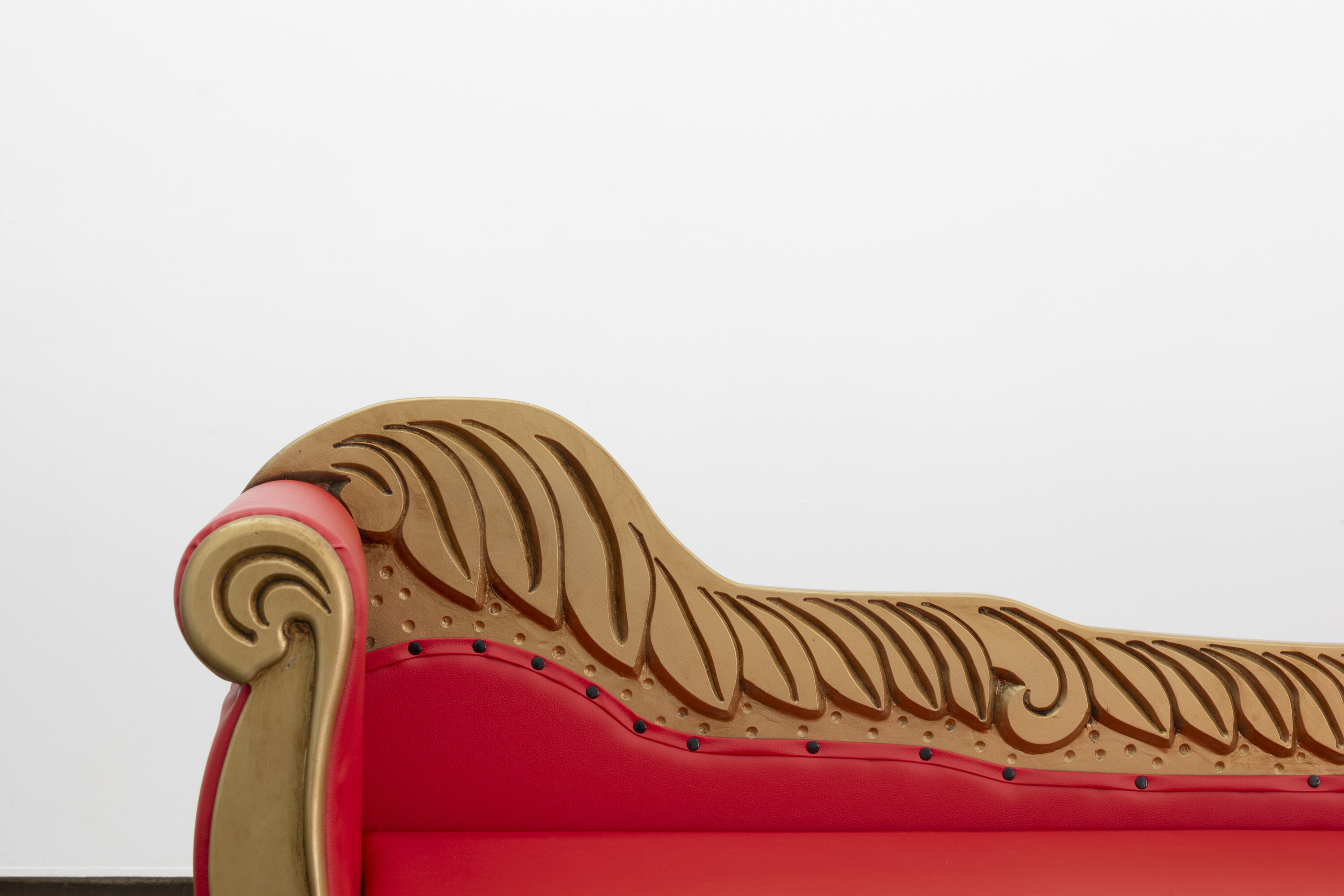
Detail of Lisa Myeong-Joo, The Red Chair in Your Picture Does Not Exist, 2024, steel, plywood, PVC, vinyl, PU foam, acrylic, 400 x 84.5 x 42 cm. Photo: Jessica Maurer
Importantly, Myeong-Joo’s chair is not only a chair but a prop. The artist worked with Pink Cactus Props, based on Gadigal and Bidjigal lands in southern Sydney, to fabricate the chair; the gold banding of the chaise lounge, touched up with bitumen to create the patina of age, is their distinctly theatrical handiwork. Props, unlike regular objects, have special properties: they are objects at the same time as they possess a quality (an aura?) in excess of the object. Like a limit inscribed in the dirt, a prop is a productive threshold: an umbilical cut that simultaneously demarcates one reality as it opens out onto others. On stage, prop magic transforms a slab of polystyrene into a bench, a tree, or a tombstone or turns a roll of blue fabric, clasped and wiggled by two enthusiastic preschoolers, into the sea. But unlike a fabric wave, a chair that is a prop can be experienced (sat on, stood on, or hurled) in the same way as a chair that is “just” a chair; in other words, a prop chair both is and isn’t.
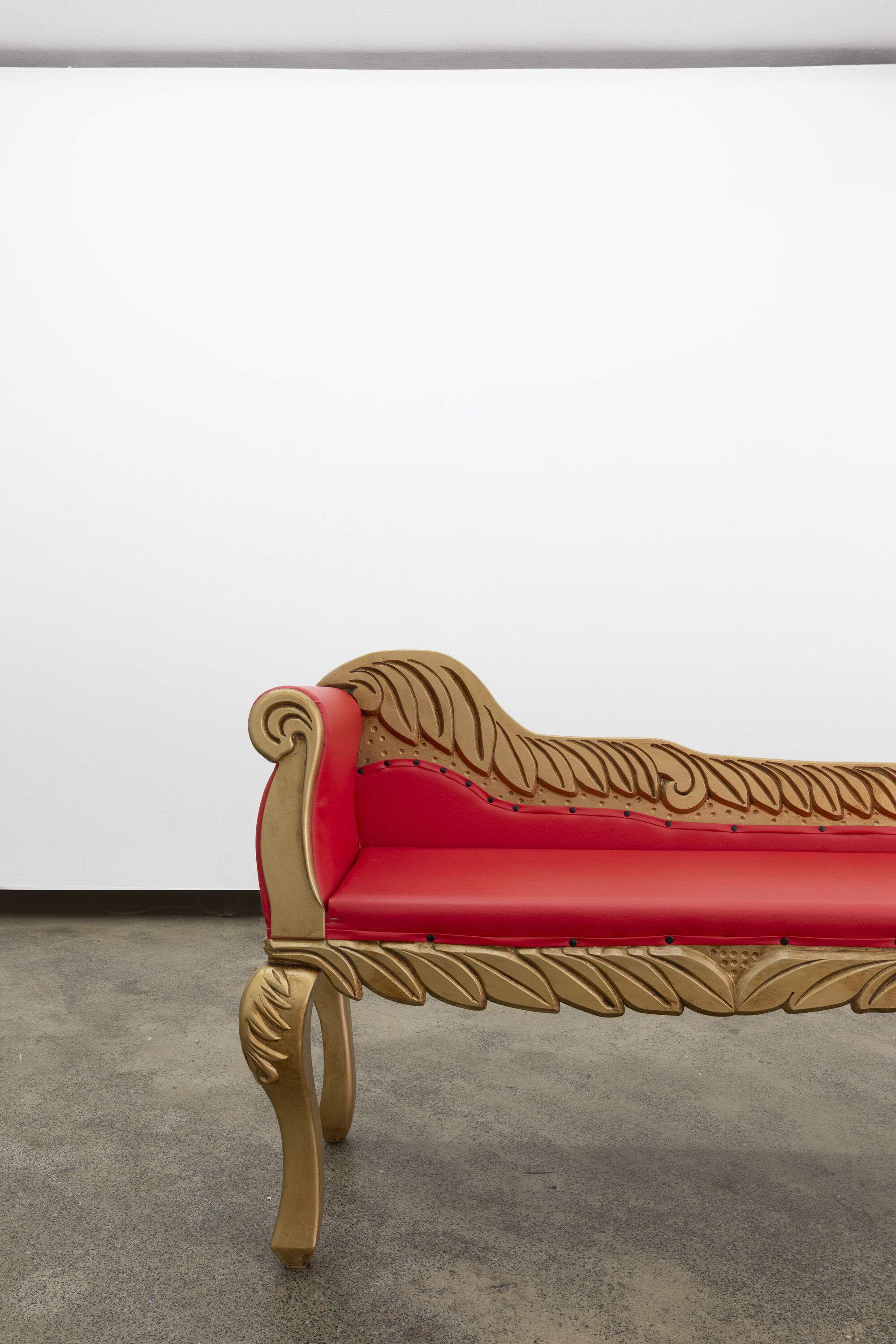
Lisa Myeong-Joo, The Red Chair in Your Picture Does Not Exist, 2024, steel, plywood, PVC, vinyl, PU foam, acrylic, 400 x 84.5 x 42 cm. Photo: Jessica Maurer
Real and unreal, Myeong-Joo’s reproduction of the photo chair thus conjures a theatre without threshold, a shimmering representational excess of documentary evidence. More than merely re-staging the chair’s existence, the artist’s mischievous affirmation translates the chair across space and time, reminding us that every representation is also an act of translation. When it first appeared in 1425, the word “properties” referred to objects collectively owned by travelling theatre troupe members. In this sense, a prop also belongs without belonging to one place: it moves and travels. Translation, itself a type of movement, offers no direct equivalence between one expression and the next. There is always a third term (a third body, swollen with the potential of all meaning) that exceeds the sterile language of bureaucracy. I think of the poet and translator Don Mee Choi, who uses strategies of linguistic and visual translation to subvert the ongoing military occupation of South Korea. In her pamphlet “Translation is a Mode = Translation is an Anti-neocolonial Mode” (2020), Choi speaks to the way that translation, as a movement across, between, and through languages, can be used as a type of counter-mapping that erases and redraws colonial borders.
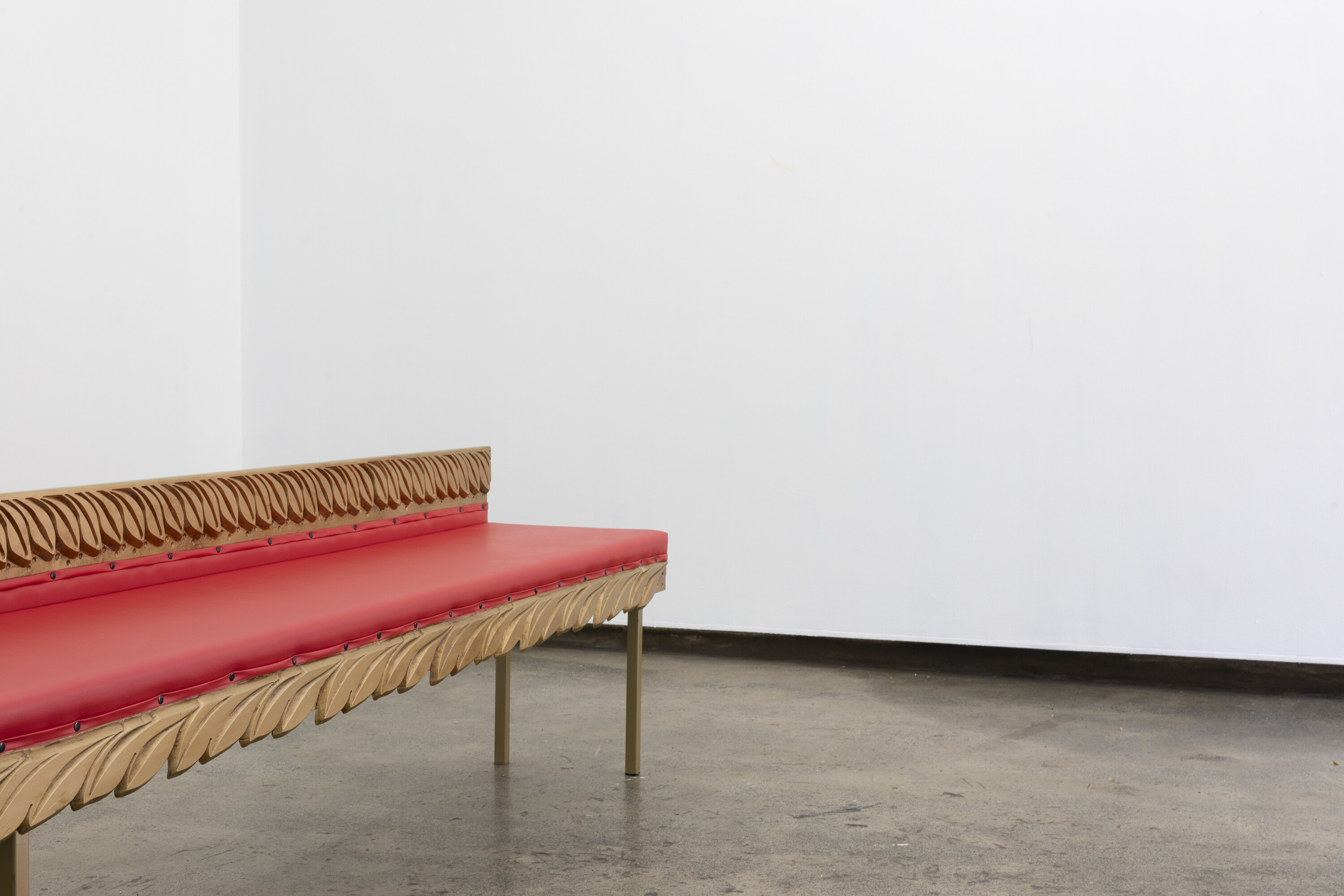
Lisa Myeong-Joo, The Red Chair in Your Picture Does Not Exist, 2024, steel, plywood, PVC, vinyl, PU foam, acrylic, 400 x 84.5 x 42 cm. Photo: Jessica Maurer
A photo is taken, and a child moves from one place to another and is translated across space and time, through language and border zones. Yet in The Red Chair in Your Picture Does Not Exist, the chair in question, a leftover prop of US imperialism, becomes a portal, a magical object cathected with the mystery of smoke, mirrors, and trapdoors. By inviting prop makers to collaborate in the chair’s production, Myeong-Joo also subtly shifts the locus of adoption from exchange (the movement from A to B) to labour, and thus from the paternal remit of the state to the polyvalence of the word “mother.” The chair becomes a site of collective holding—a larger-than-life support for staging a shared encounter. Entering the gallery, I sit on the chair and turn to the person seated next to me; there is no camera flash, no archive.
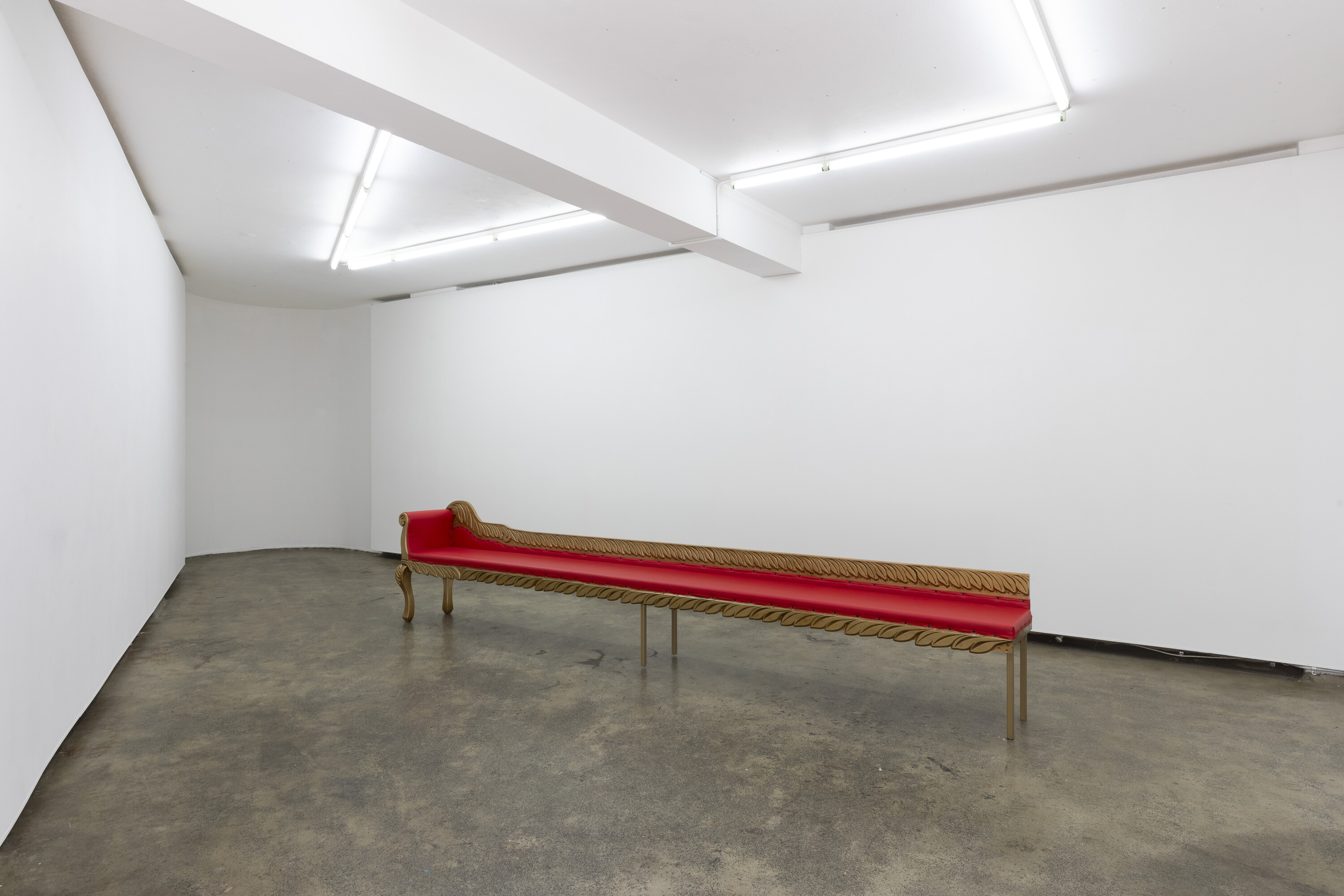
Lisa Myeong-Joo, The Red Chair in Your Picture Does Not Exist, 2024, steel, plywood, PVC, vinyl, PU foam, acrylic, 400 x 84.5 x 42 cm. Photo: Jessica Maurer
I am tempted to recline and rest my head on the arm of the chaise lounge. Popularised by Sigmund Freud, the chaise lounge is also the chair of psychoanalysis; Freud’s study in London still houses his famous chaise lounge, adorned with a Qashqa’i shekarlu carpet. In a traditional psychoanalytic session, the analysand lies back on the chaise lounge while the analyst (with or without a cigar) sits in a chair behind them. Neither the analysand nor the analyst makes eye contact: the analyst listens while the analysand speaks. Once again, I think of Don Mee Choi, this time about a conversation between Choi and the poet Kim Hyesoon. When asked about her thoughts on translation, Hyesoon responded that translation means “listening to the sounds of the body,” holding an ear to its wet and liquid chambers. But “session” (i.e., a psychoanalytic session) shares its etymology with “séance” from the Old French seoir, “to sit.” If a “sitting” can be a séance, it also implies a particular orientation toward absence: a remembering, a working through, an invocation, a listening—a communion with unruly spirits who are all jostling to get in frame.
Toyah is a writer and educator living on Wangal land.


